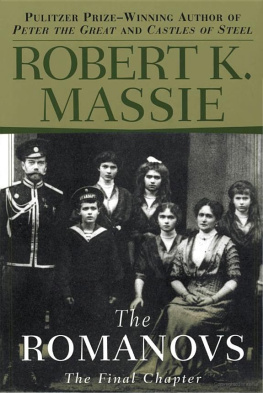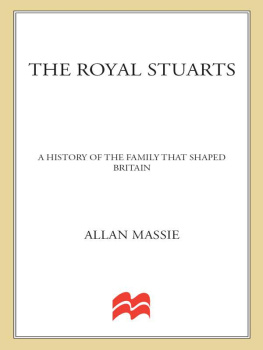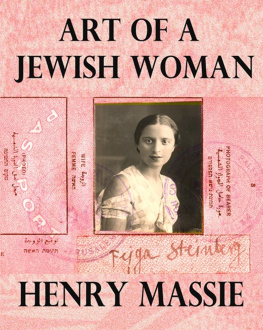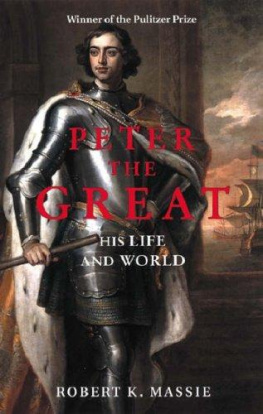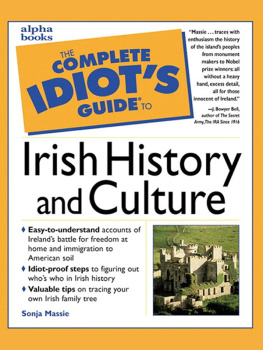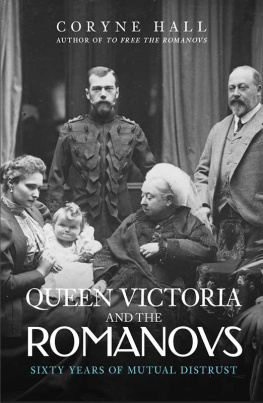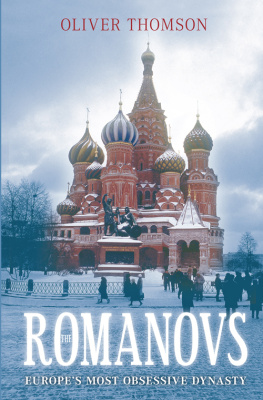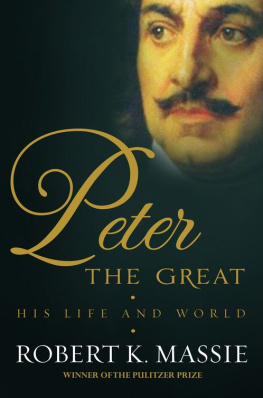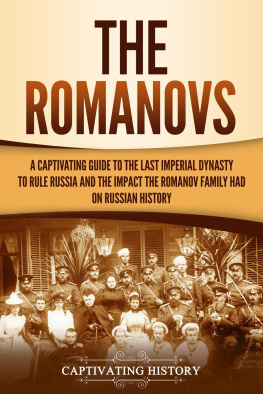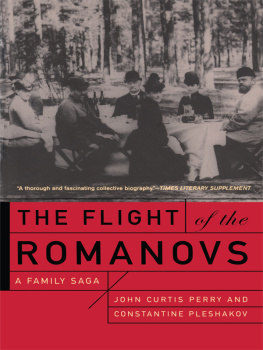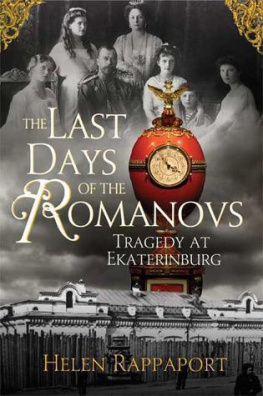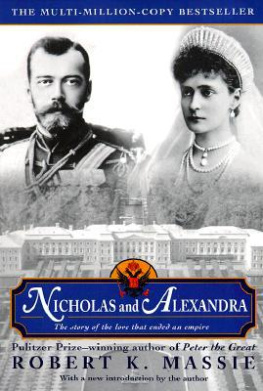A LSO BY R OBERT K. M ASSIE
Nicholas and Alexandra
Peter the Great
Dreadnought
Journey (coauthor)
Castles of Steel
ABOUT THE AUTHOR
R OBERT K. M ASSIE was born in Lexington, Kentucky, and studied American history at Yale and modern European history at Oxford, which he attended as a Rhodes Scholar. He was president of the Authors Guild from 1987 to 1991. His previous books include Nicholas and Alexandra, Peter the Great: His Life and World (for which he won a Pulitzer Prize for Biography), The Romanovs: The Final Chapter, and Dreadnought: Britain, Germany, and the Coming of the Great War.
SOURCES AND
ACKNOWLEDGMENTS
Most of the written sources of my understanding of Nicholas II, his family, and his era are listed in the bibliography of my earlier book Nicholas and Alexandra. For this new book, I carefully reread Nicholas Sokolovs Enquete Judiciaire sur lAssassinat de la Famille Impriale Russe and Pavel M. Bykovs The Last Days of Tsardom. The Yurovsky note was unavailable when my first book appeared, and I, like many others, put too much faith in Sokolovs conclusion that the bodies had been destroyed. Yurovskys account of the murders, first revealed by Edvard Radzinsky in 1989 and later included in his book The Last Tsar, described what actually happened and helped Alexander Avdonin and Geli Ryabov discover where the bodies were.
Essentially, the source material for the present book was not in written form; it came from over one hundred interviews with people in Ekaterinburg, Moscow, London, Birmingham, Paris, Copenhagen, Madrid, Gstaad, Ulm, New York City, Albany, Hartford, Boston, Washington, Charlottesville, Durham, Gainesville, Palm Beach, Austin, Phoenix, Berkeley, and Jordanville, New York. Helping me with the first part of the book, The Bones, were many Russians, including Dr. Sergei Abramov, Alexander and Galina Avdonin, Dr. Pavel Ivanov, Nikolai Nevolin, Geli Ryabov, Vladimir Soloviev, Sergei Mironenko, Prince Alexis Scherbatow, Metropolitan Vitaly, Archbishop Laurus, Bishop Hilarion, Bishop Basil Rodzianko, and Father Vladimir Shishkoff. I am very grateful to all of them. I wish to thank Dr. Peter Gill, Karen Pearson, Prince Rostislav Romanov, Michael Thornton, Julian Nott, Nigel McCrery, and Barbara Whittal for the help I received in England. In the United States, I was assisted by James A. Baker III, Margaret Tutwiler, Grace and Ron Moe, Bill Dabney, Mike Murrow, Dr. William Maples, Dr. Michael Baden, Dr. Lowell Levine, Dr. William Hamilton, William Goza, Cathryn Oakes, Dr. Charles Ginther, Dr. Alka Mansukhani, Dr. Walter Rowe, Dr. Richard Froede, Dr. Bill Rodriguez, Matt Clark, Mark Stolorow, Marilyn Swezey, and Robert Atchison.
On Romanov impostors in general, Alexander Avdonin, Edvard Radzinsky, Vladimir Soloviev, Prince Nicholas Romanov, Ricardo Mateos Sainz de Medrano, Pavel Ivanov, Bishop Basil Rodzianko, Marilyn Swezey, and Victor Dricks all told me interesting stories. In The Romanov Conspiracies, Michael Occleshaw describes the escape and subsequent life of Larissa Feodorovna Tudor.
On Michael Goleniewski and Eugenia Smith, I was greatly assisted by Countess Dagmar de Brantes, Brien Horan, Bishop Gregory (formerly Father George Grabbe), Father Vladimir Shishkoff, Dr. Richard Rosenfield, David Martin, David Gries, Leroy A. Dysick, and Denis B. Gredlein. David Martins Wilderness of Mirrors and Guy Richardss The Hunt for the Tsar contained useful information about Michael Goleniewski.
The literature on Anna Anderson is extensive and, undoubtedly, will continue to expand. It includes a purported autobiography, I Am Anastasia (or, in England, I, Anastasia), of which Anna Anderson had no knowledge until she was presented with a finished copy of the book. Most of the early witnesses and disputants put their opinions in writing; among these works I read Anastasia, by Harriet Rathlef-Keilman, La Fausse Anastasie, by Pierre Gilliard and Constantin Savitch, The Real Romanovs and The Woman Who Rose Again, by Gleb Botkin, The Last Grand Duchess (Olga, Nicholas IIs sister), by Ian Vorres, Anastasia, Qui tes-Vous?, by Dominique Auclres, and The House of Special Purpose, by J. C. Trewin (compiled from the papers of Charles Sidney Gibbes, the English tutor of the Imperial children). There are two relatively recent biographies of Anna Anderson: Anastasia: The Riddle of Anna Anderson, by Peter Kurth, and Anastasia: The Lost Princess, by James Blair Lovell. In depth of research, style of writing, and seriousness of purpose, Kurths book is infinitely superior. Brien Horan was kind enough to give me a copy of his unpublished manuscript on the evidence on both sides of the Anna Anderson case. I am grateful to Dr. Gunther von Berenberg-Gossler for permitting me to see a chapter of his unpublished work on Franziska Schanzkowska.
Michael Thornton was generous, not only with his vast collection of Anna Anderson correspondence and memorabilia, but with his time and counsel. Similarly, Brien Horan helped me greatly with his knowledge of Anna Anderson and of the Romanov family schism. John Orbell of Baring Brothers, William Clarke, author of The Lost Treasures of the Tsar, and H. Leslie Cousins of Price, Waterhouse assisted me in grappling with the disputed story of Romanov money in English banks.
The account of the legal proceedings in Charlottesville is drawn exclusively from interviews and conversations. In this respect, Richard and Marina Schweitzer, whose integrity and honorable effort I greatly admired although I never was able to share their belief, were indispensable. In addition, I am grateful to Susan Burkhart, Mary DeWitt, Mildred Ewell, Baron Eduard von Falz-Fein, Dr. Peter Gill, Dr. Charles Ginther, Vladimir Galitzine, Ron Hansen, Penny Jenkins, Dr. Willi Korte, Peter Kurth, Syd Mandelbaum, Matthew Murray, Ann Nickels, Julian Nott, Maurice Philip Remy, Dean Robinson, Rhonda Roby, Prince Alexis Scherbatow, and Michael Thornton.
My chapter on the Romanov survivors and the possibility of a restoration of the dynasty in Russia benefited from conversations with Marina Beadleston, Prince Dimitri and Princess Dorrit Romanov, Grand Duke George, Grand Duchess Leonida, Grand Duchess Maria, Prince Michel Romanov, Prince Nicholas and Princess Sveva Romanov, Prince Rostislav Romanov, Paul R. and Angelica Ilyinsky, Xenia Sfiris, Prince Franz of Prussia, Prince Giovanni di Bourbon-Sicilies, Prince George Vassiltchikov, Professor Irina Pozdeeva, Dr. Pavel Ivanov, Geli Ryabov, Jose Luis Sampredo Escolar, Ricardo Mateos Sainz de Medrano, and Albert Bartridge.
Edward Kasinec, chief of the Slavic and Baltic Division of the New York Public Library, gave me invaluable assistance, and his colleague Sergei Gleboff also helped me. Deborah Baker was the first to mention to me the link between DNA fingerprinting and the Romanov bones. Edmund and Sylvia Morris made me feel at home in Washington, taking time from their own books to give counsel on mine. Hannah Pakula loaned me a rare book from her library. Ian Lilburne permitted me to use his pictures. Howard Ross dropped everything for several days to help with other pictures. Annick Mesko, Jacques Ferrand, Julia Kort, Victoria Lewis, and Petra Henttonen contributed comments, questions, and multilingual translations. Ken Burrows, Jeremy Nussbaum, and Nancy Feltsen stepped forward in times of trouble. I am greatly indebted to Dolores Karl, who listened to several hundred hours of taped interviews and turned what she heard into several thousand pages of clean, workable transcript. In addition, she rescued me whenever I was losing a battle with my new (and first) computer word processor.
Next page
